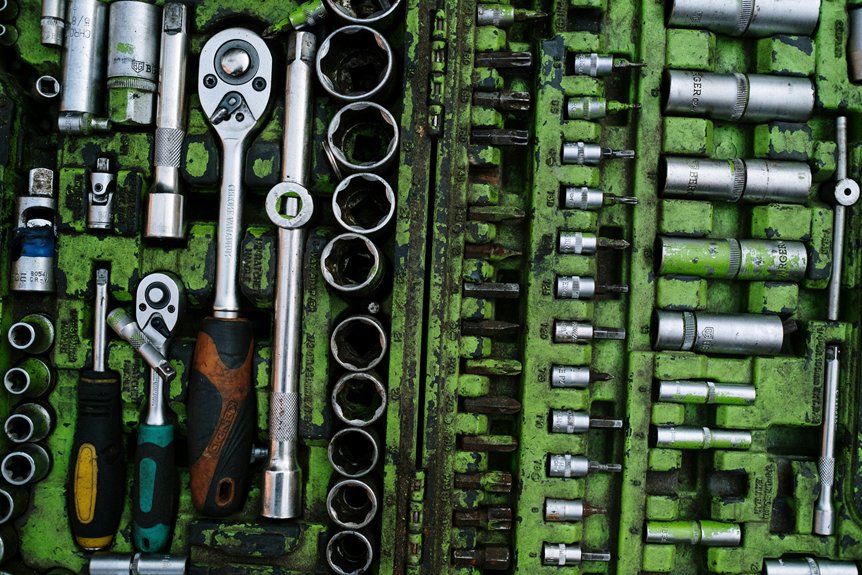Maintaining your whole home humidifier is essential for ensuring ideal performance and air quality. By following a few necessary tips, you can enhance efficiency and prolong the lifespan of your system. From regular water changes to professional maintenance, each step plays a critical role. Understanding these practices will help you create a healthier living environment. Let’s explore these key strategies to keep your humidifier running smoothly.
Key Takeaways
- Change water in the humidifier weekly, using clean, distilled water to prevent mineral buildup and enhance efficiency.
- Regularly clean components and filters with a vinegar solution to maintain air quality and prevent clogs.
- Monitor humidity levels weekly with a hygrometer, aiming for an ideal range of 30% to 50%.
- Schedule annual professional inspections to ensure optimal performance and identify potential issues early.
- Replace clogged filters promptly and document replacement dates to maintain humidifier efficiency.
Regularly Change the Water in Your Humidifier

To maintain prime performance, you should change the water in your humidifier at least once a week.
Different humidifier types may have specific requirements, but regular water changes enhance water quality and prevent the growth of harmful bacteria and mold.
Stagnant water can lead to poor humidity levels and affect overall indoor air quality.
Whether you use an evaporative, steam, or ultrasonic model, make sure you’re using clean, filtered water to maximize function.
Remember, the better the water quality, the more efficient your humidifier will be in maintaining a comfortable environment in your home.
Stay proactive for best results.
Clean the Humidifier Components Frequently
Changing the water weekly is just one part of keeping your humidifier running smoothly.
Regularly clean the humidifier components using effective cleaning techniques to prevent buildup and guarantee maximum performance. Focus on areas like the water reservoir, filters, and any other removable parts.
Use a mixture of vinegar and water to disinfect these components, and rinse thoroughly afterward. This component care routine not only extends your humidifier’s lifespan but also improves air quality.
Make it a habit to inspect and clean these parts every month or as recommended by the manufacturer to maintain peak efficiency.
Monitor Humidity Levels With a Hygrometer

To maintain ideal comfort and air quality, you need to monitor humidity levels in your home.
The ideal humidity range is typically between 30% and 50%, and using a hygrometer—either digital or analog—will help you keep track.
Regularly checking these levels guarantees your humidifier operates efficiently and prevents potential issues.
Ideal Humidity Range
Maintaining a perfect humidity range in your home is essential for comfort and health, with levels between 30% and 50% being preferable.
This ideal humidity helps prevent issues such as mold growth, dust mites, and respiratory problems. Conversely, low humidity can lead to dry skin, irritated airways, and increased static electricity.
To monitor humidity effects, use a hygrometer to guarantee your home stays within this range. If levels fall outside the perfect spectrum, adjust your whole home humidifier accordingly.
Regular checks will help you maintain a healthy environment, promoting well-being and comfort for you and your family.
Digital vs. Analog Hygrometers
When it comes to monitoring humidity levels, you have two main options: digital and analog hygrometers. Digital hygrometers provide precise readings and often feature additional functionalities, such as temperature display and memory functions. On the other hand, analog hygrometers are simple, durable, and don’t require batteries.
| Feature | Digital Hygrometers | Analog Hygrometers |
|---|---|---|
| Accuracy | High | Moderate |
| Battery Requirement | Yes | No |
| Readability | Easy to read | Requires interpretation |
| Durability | Moderate | High |
Choose based on your needs!
Regular Monitoring Frequency
Regularly monitoring humidity levels is essential for maintaining a comfortable and healthy home environment.
Use reliable monitoring tools like hygrometers for accurate humidity tracking. Check your humidity levels at least once a week, adjusting your whole home humidifier as needed to keep levels between 30% and 50%.
Higher or lower levels can lead to discomfort and health issues. If you notice fluctuations, increase your monitoring frequency until stability returns.
Remember, proactive monitoring not only enhances comfort but also protects your home from potential damage caused by excessive moisture or dryness.
Stay vigilant to maintain ideal humidity levels year-round.
Replace Filters as Recommended
To guarantee peak performance, you should always follow the manufacturer guidelines regarding filter replacement.
Regularly check the condition of your filters, as clogged filters can hinder efficiency and air quality.
Additionally, scheduling regular maintenance checks can help you stay on top of your humidifier’s needs.
Follow Manufacturer Guidelines
Although maintaining a whole home humidifier may seem straightforward, adhering to the manufacturer’s guidelines—particularly regarding filter replacements—is essential for maximum performance.
By following the manufacturer instructions, you guarantee ideal humidity levels and protect your product warranty. Neglecting these guidelines can lead to decreased efficiency and potential damage.
- Check the recommended replacement schedule
- Use only compatible filters
- Document replacement dates for reference
- Consult the manual for troubleshooting tips
Staying diligent about these practices not only enhances your humidifier’s longevity but also maintains a healthy indoor environment for you and your family.
Check Filter Condition Regularly
Maintaining ideal filter condition is essential for your whole home humidifier’s performance.
Regularly check the filter types installed in your system, as different models may require specific maintenance. Over time, filters accumulate dust and debris, impacting efficiency and air quality.
Most filters have a defined filter lifespan, which varies based on usage and environmental factors. Replace filters as recommended by the manufacturer to guarantee peak function.
Ignoring filter maintenance can lead to reduced humidity levels and increased energy consumption.
Stay proactive in checking and replacing your filters to keep your humidifier running smoothly and effectively.
Schedule Regular Maintenance Checks
Scheduling regular maintenance checks for your whole home humidifier is essential for peak performance and longevity.
By adhering to a maintenance checklist and making seasonal adjustments, you’ll guarantee your system runs efficiently. Don’t forget to replace filters as recommended to maintain ideal humidity levels.
- Check filters every 1-3 months
- Inspect water supply lines for leaks
- Clean the humidifier tank periodically
- Test the system’s functionality before seasonal changes
These steps not only prolong your humidifier’s lifespan but also enhance air quality, providing a comfortable living environment year-round.
Stay proactive and keep your humidifier in top shape!
Inspect and Seal Ductwork for Efficiency

Inspecting and sealing your ductwork is essential for maximizing the efficiency of your whole home humidifier.
Start with an airflow analysis to identify any leaks or blockages in your ducts. Even small gaps can greatly impact humidity levels and energy usage.
Use quality duct sealing materials to repair any identified issues, ensuring a tight seal that minimizes air loss.
Regular inspections help maintain ideal performance, allowing your humidifier to work effectively throughout your home.
By addressing duct issues promptly, you not only enhance humidity control but also promote a more comfortable living environment.
Prioritize this step for best results.
Schedule Professional Maintenance Annually
While regular upkeep is essential for your whole home humidifier, scheduling professional maintenance annually guarantees peak performance and longevity.
Annual checkups are vital for identifying potential issues and confirming your system operates efficiently. Here’s why maintenance is important:
- Detects hidden problems before they escalate
- Optimizes energy efficiency, lowering utility costs
- Extends the lifespan of your humidifier
- Confirms consistent humidity levels throughout your home
Don’t overlook the value of expert inspections; they help maintain a comfortable and healthy living environment.
Invest in professional maintenance to keep your system running smoothly all year round.
Use Distilled Water to Minimize Mineral Build-Up

To keep your whole home humidifier functioning efficiently, consider using distilled water instead of tap water.
Distilled water offers significant distilled benefits, primarily due to its lack of minerals. When you use tap water, minerals can accumulate in your humidifier, leading to clogs and reduced performance.
By choosing distilled water, you’ll achieve effective mineral reduction, which not only prolongs your humidifier’s lifespan but also enhances air quality.
This simple switch minimizes maintenance needs and guarantees ideal humidity levels in your home.
Ultimately, using distilled water is a smart, proactive choice for maintaining a healthy, efficient humidification system.
Conclusion
By following these seven key tips, you can master whole home humidifier maintenance and guarantee peak performance. Regularly changing the water, cleaning components, and monitoring humidity levels are essential for air quality. Don’t forget to replace filters, inspect ductwork, and schedule annual professional maintenance. Using distilled water will further reduce mineral buildup. Implementing these strategies not only enhances your humidifier’s efficiency but also contributes to a healthier living environment for you and your family.

